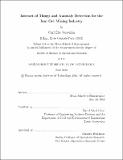Internet of Things and anomaly detection for the iron ore mining industry
Author(s)
Saroufim, Carl Elie
DownloadFull printable version (9.314Mb)
Alternative title
IoT and anomaly detection for the iron ore mining industry
Other Contributors
Massachusetts Institute of Technology. Operations Research Center.
Advisor
David Simchi-Levi.
Terms of use
Metadata
Show full item recordAbstract
In the context of a world flooded with data, the Internet of Things (IoT) is exploding. This thesis considers the problem of applying IoT technology to the reduction of costs in the iron ore mining industry, to compensate for the iron ore price slumping observed over the past years. More specifically, we focused on improving the quality of the output in a data-driven iron ore concentration factory. In this plant, mined iron ore goes through a series of complex physical and chemical transformations so as to increase the concentration in iron and reduce the concentration in impurities such as silica. In this thesis, we developed an IoT infrastructure comprising of machines, a network of sensors, a database, a random forest prediction model, an algorithm for adjusting its cutoff parameter dynamically, and a predictive maintenance algorithm. It can preventively detect and maybe fix poor quality events in the iron ore concentration factory, improving the overall quality and decreasing costs. The random forest model was selected among other anomaly detection techniques. It is able, on an independent test data set, with an AUC of about 0.92, to detect 90% of the poor quality events, with a false positive rate of 23.02%, lowered by the dynamic cutoff algorithm. These methods can be applied to any factory in any industry, as long as it has a good infrastructure of sensors, providing sufficiently precise and frequent data.
Description
Thesis: S.M., Massachusetts Institute of Technology, Sloan School of Management, Operations Research Center, 2016. This electronic version was submitted by the student author. The certified thesis is available in the Institute Archives and Special Collections. Cataloged from student-submitted PDF version of thesis. Includes bibliographical references (pages 176-182).
Date issued
2016Department
Massachusetts Institute of Technology. Operations Research Center; Sloan School of ManagementPublisher
Massachusetts Institute of Technology
Keywords
Operations Research Center.